Read Time: 5 Minutes Subscribe & Share
Pandemic Pastime
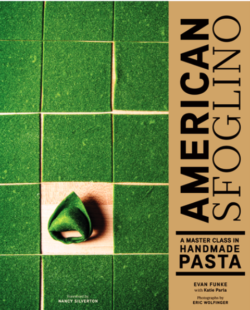 Kitchen Detail posts have touched on the Pandemic and the subtle and not-so-subtle changes to our everyday
Kitchen Detail posts have touched on the Pandemic and the subtle and not-so-subtle changes to our everyday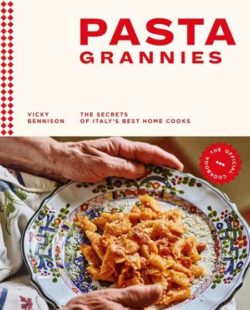 habits, interests, and past-times. For me, reading cookbooks during the Pandemic reinforced an old habit: cracking open a new or vintage cookbook and reading it like a novel. During the early days of the Pandemic, I was seduced by the cover of Evan Funke’s American Sfoglino, A Master Class in Handmade Pasta. The spinach-green pasta on the cover, the artful photos, the mystique of this burly “hells angels” kinda guy making perfect tiny tortellini with his beefy, inked arms and banana-size fingers made me want to buy all the doppio zero (00) flour I could find and make pasta. Then, a friend suggested Pasta Grannies, The Secrets of Italy’s Best Home Cooks by Vicky Bennison. I fell in love with the nonne or “grannies” whom I understood intuitively. These septuagenarians, octogenarians and even some nonagenarians from all over Italy transported me to the kitchens of my childhood where Sundays meant making pasta with my mother, grandmother, and aunts. Page after page, I felt my muscle memory kick in and I was transported to my mother’s safe, noisy, and tomato sauce-perfumed kitchen.
habits, interests, and past-times. For me, reading cookbooks during the Pandemic reinforced an old habit: cracking open a new or vintage cookbook and reading it like a novel. During the early days of the Pandemic, I was seduced by the cover of Evan Funke’s American Sfoglino, A Master Class in Handmade Pasta. The spinach-green pasta on the cover, the artful photos, the mystique of this burly “hells angels” kinda guy making perfect tiny tortellini with his beefy, inked arms and banana-size fingers made me want to buy all the doppio zero (00) flour I could find and make pasta. Then, a friend suggested Pasta Grannies, The Secrets of Italy’s Best Home Cooks by Vicky Bennison. I fell in love with the nonne or “grannies” whom I understood intuitively. These septuagenarians, octogenarians and even some nonagenarians from all over Italy transported me to the kitchens of my childhood where Sundays meant making pasta with my mother, grandmother, and aunts. Page after page, I felt my muscle memory kick in and I was transported to my mother’s safe, noisy, and tomato sauce-perfumed kitchen.
The Pros
 It would be easy to compare both books and divide into camps: American Sfoglino vs. Pasta Grannies. But that is not the point. Both are great pasta-making resources, offering a ton of techniques and sauce recipes that can be used with fresh or, in a pinch, dry pasta. Evan Funke’s American Sfoglino is a
It would be easy to compare both books and divide into camps: American Sfoglino vs. Pasta Grannies. But that is not the point. Both are great pasta-making resources, offering a ton of techniques and sauce recipes that can be used with fresh or, in a pinch, dry pasta. Evan Funke’s American Sfoglino is a 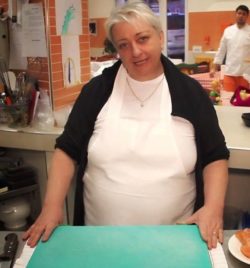 Master Class in pasta making. An American-born professional chef who found himself at personal and professional crossroads, Funke landed in Italy with the desire to make pasta by hand. His journey led him to Bologna, where the pasta maker or sfoglino is the foundation of Bolognese cuisine. He learned the craft from Sfoglina Maestra Alessandra Spisni at La Vecchia Scuola Bolognese, where he also met and learned the Japanese systematic approach to pasta-making from Kosaki Kowamura, the “Japanese Sfoglino”. The Fundamentals section offers a step-by-step how-to on egg, water, and spinach pasta and gnocchi. The rest of the book teaches you how to make 15 different pasta types ~ rolled, cut, filled, and layered, with recipes and tips for each. The beautiful, studio-quality color photos make the process look easy. This book is a love letter to Bologna, complete with a resource section on eating, drinking, and shopping while there.
Master Class in pasta making. An American-born professional chef who found himself at personal and professional crossroads, Funke landed in Italy with the desire to make pasta by hand. His journey led him to Bologna, where the pasta maker or sfoglino is the foundation of Bolognese cuisine. He learned the craft from Sfoglina Maestra Alessandra Spisni at La Vecchia Scuola Bolognese, where he also met and learned the Japanese systematic approach to pasta-making from Kosaki Kowamura, the “Japanese Sfoglino”. The Fundamentals section offers a step-by-step how-to on egg, water, and spinach pasta and gnocchi. The rest of the book teaches you how to make 15 different pasta types ~ rolled, cut, filled, and layered, with recipes and tips for each. The beautiful, studio-quality color photos make the process look easy. This book is a love letter to Bologna, complete with a resource section on eating, drinking, and shopping while there.
The Grannies
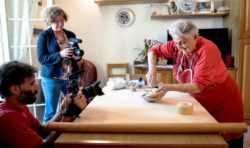 Vicky Bennison’s Pasta Grannies invites you into the kitchens of le nonne across several of Italy’s regions from Piedmont to Basilicata. English-born Bennison first tasted spaghetti and tomato sauce in Venice at age 5 while travelling with her parents. For her, food was not merely nutrition or fuel: it was family, community, and everyday adventure. At her home in the Le Marche region, she noted how the over-80-year-old women made pasta for their families using techniques passed from mother to daughter. She recognized that changing times made it essential to record and celebrate these older women.
Vicky Bennison’s Pasta Grannies invites you into the kitchens of le nonne across several of Italy’s regions from Piedmont to Basilicata. English-born Bennison first tasted spaghetti and tomato sauce in Venice at age 5 while travelling with her parents. For her, food was not merely nutrition or fuel: it was family, community, and everyday adventure. At her home in the Le Marche region, she noted how the over-80-year-old women made pasta for their families using techniques passed from mother to daughter. She recognized that changing times made it essential to record and celebrate these older women.
Five years of interviews, filming, and recording the grannies produced this cookbook-documentary that transports you to the Abruzzo mountains, the Sardinian seaside, and the hardscrabble land of Basilicata, among others. The Introduction focuses on making egg and durum wheat pasta, offers tools and how-to photos. The biographical sketches set the stage and introduce you to the nonne, their families and their homes. The eight chapters, from nuts and herbs to ravioli and tortelli show the diversity of pasta and its foundation to Italian home cooking. What makes this cookbook a standout are the images. Here you find the nonne in everyday dress, sitting along a balcony, making pasta with a granddaughter, tables set with homespun colorful tablecloths, and photo after photo of gnarly fingers and skilled hands that make dishes of pasta for family and friends.
Reflections On Reading & Cooking
Growing up with Italian women who look, act, and cook like those in Pasta Grannies, I feel more at home and less intimidated to try the recipes. American Sfoglino looks and feels more upmarket, as though the professional chef at Felix Trattoria in Los Angeles is looking over my shoulder and I dare not make a mistake.
The marketing for both books reflects the times, and during the Pandemic are welcomed additions: via articles in print, YouTube, their Instagram feeds and respective websites. Tune in to their YouTube videos and the difference in style becomes apparent immediately. Pasta Grannies transports you into everyday kitchens, the nonne speak Italian while walking you through the recipe. Evan Funke takes you to his chef kitchen 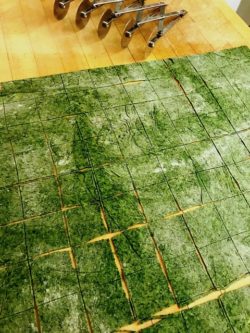 where his love of pasta and traditional methods softens one’s jarring reaction to his salty, four-letter-laced narratives.
where his love of pasta and traditional methods softens one’s jarring reaction to his salty, four-letter-laced narratives.
These two books offer the home cook a primer on pasta-making, but more importantly, they continue the story arc of food as cultural, emotional, and communal; memorialize the tradition of hand-made pasta making; and introduce us to a wealth of culinary knowledge and technique that needs to be passed from generation to generation.
Nancy worked with the recipes in both books. You will learn and you will gradually head toward the perfection you see in the detailed photos and text of Evan Funke’s book. It is a bit like the old joke of how you get to Carnegie Hall – practice, practice, practice. My spinach tortelloni came out well after about three or four tries. My farfalle, not so much, more like flattened moths, but I persist. His recipes and techniques are solid.
Pasta Grannies recipes in the book benefit from watching the videos. Instructions and ingredient amounts are a bit shaky. My slavish following of one had to be discarded. Another, with adjustments made after watching the video and tweaking the recipe, worked out a lot better. Still, the variety of sauces and pastas, while the details are blurred, are a cure for pandemic blues.
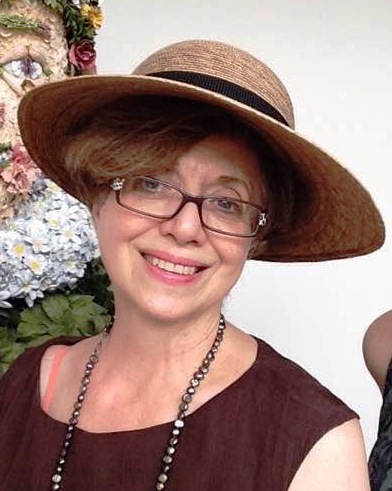
Liz DiGregorio, newest Cuisinette, retired from a career in emergency management. She bought Julia Child’s Mastering the Art of French Cooking in 1967 and has been cooking ever since. Her love of Italian food is rooted in her DNA. When not re-arranging her cookbook library, she can be found in the garden, English mystery in hand and plotting her next escape from DC.




I will try to forward this article to my son-in-law who is the legend of sales at the mass flour milling company, Ardent Mills. He is always interested in “boutique flours” and tasty breadmaking.
My son has just started making kinds of pasta by hand and will also be interested. I will enjoy reading but my arthritic hands make it difficult to form intricate shapes. I am looking for the perfect whole wheat bread recipe, so will pursue at least one of the books..